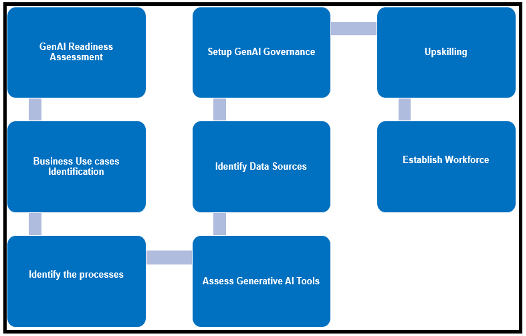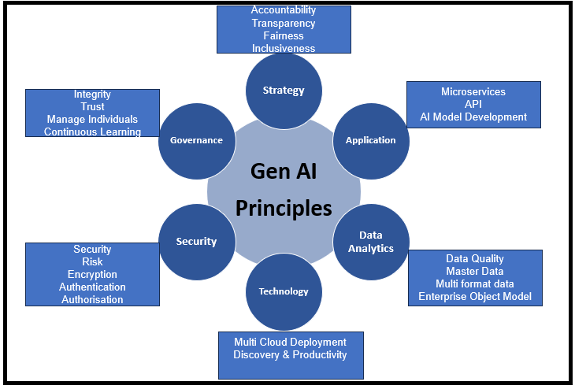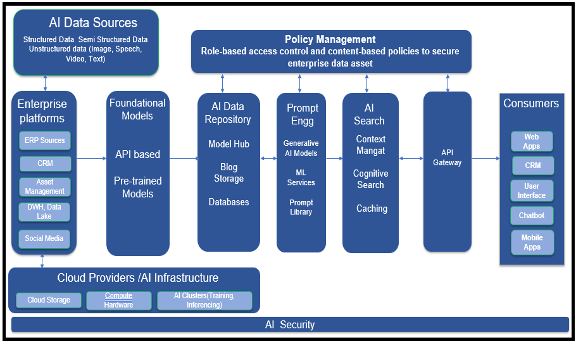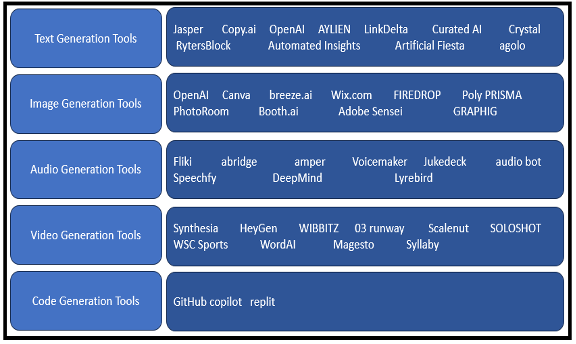
(Part 1 appeared yesterday in A&G here)
Dr. Gopala Krishna Behara
Generative AI Adoption Steps
The following are the steps to follow to perform Generative AI adoption across the enterprise.

Figure 2: Generative AI Adoption Steps
- Generative AI Readiness Assessment: establish an executive team for identifying and overseeing the AI initiatives across the organization. Define a clear vision and strategy for Generative AI implementation aligned with the enterprise goals and business functions. Develop practical communications to, and appropriate access for employees.
- Business Use cases Identification: Identify the business challenges that requires attention. Also, understand the business benefits of AI adoption that are critical for the success of enterprise. Select the targeted use cases and perform the Proof of Concepts (POC) that can deliver desired business and operational outcomes. Build value through improved productivity, growth, and new business models.
- Identify the Processes: Understand the impact of AI solutions and determine its success measurement. Create the processes for ongoing monitoring and auding of Generative AI systems for responsible use of AI to ensure compliance with legal, technical standards. Defne data access controls, data sharing agreements and data lifecycle management procedures for AI systems. Move from pilot to production, which includes integrating the Generative AI capability into a larger IT system. Iterate and learn the potential Generative AI that is in line with goals and vision of an enterprise.
- Identify Data Sources: Enable access to quality data by processing both structured and unstructured data sources.
- Assess Generative AI Tools: Evaluate Generative AI tools for the enterprise business. The tool needs to adhere to the enterprise standards like security, privacy, data handling and compliance. The tool needs to empower the stakeholders to deliver business needs and continuously improve the experiences it generates against business metrics.
- Generative AI Governance: Setup Generative AI Governance across enterprise. Define roles and responsibilities of individuals involved in Generative AI development, deployment and monitoring. Foster the collaboration between AI experts, domain experts and business stakeholders. Establish a centralized, cross-functional team to review and update Generative AI governance practices as technology, regulations and enterprise needs.
- Upskilling: Reskill the employees to improve productivity by conducting various training courses and encourage them to perform POCs. Also, based on role and skills of employees, identify the skill gaps and train them effectively to contribute better ways to the enterprise transformation initiatives.
- Establish Workforce: Educate employees in the usage of Generative AI technologies, their usage across enterprise systems, challenges of usage of Generative AI and how to overcome them. Conduct structured training to build new skills and apply new ways of thinking that deliver better experiences to end users. Formulate communication mechanism for employees to understand Generative AI technologies and their implications.
Generative AI Principles
Generative AI encompasses the design, development, and monitoring of artificial intelligence systems to augment and enhance the productivity and quality of work across enterprises.
The following diagram depicts the Generative AI principles that are categorized into Strategy, Application, Data Analytics, Technology, Security and Governance.

Figure 3: Generative AI Principles
Top 12 Generative AI principles and Rationale are described below.
Principle 1: People should be accountable for AI systems.
Rationale: Create an oversight so that humans can be accountable and in contact. Assess the impact of the system on people and organizations.
Principle 2: AI Systems should be transparent and understandable.
Rationale: Design AI systems to intelligently for the decision making. AI systems are designed to inform people that they are interacting with an AI system.
Principle 3: AI systems should treat all people fairly.
Rationale: AI systems are designed to provide a similar quality of service for identified demographic groups
Principle 4: AI systems should empower everyone and engage people.
Rationale: AI systems are designed to be inclusive in accordance with enterprise accessibility standards
Principle 5: Implement AI Microservices across enterprise.
Rationale: Rapidly build applications that leverage the Microservices components. Gem AI platform must provide a comprehensive catalog of AI-based software services across enterprises.
Principle 6: Support full life cycle AI model development.
Rationale: A Generative AI platform support an integrated full life cycle algorithm development experience.
Principle 7: Design systemic data quality management
Rationale: Train data be available for the enterprise AI systems
Principle 8: Unify all the enterprise data.
Rationale: Integrate data from numerous systems into a unified federated data. Data must be current and real-time.
Principle 9: Access multi format data
Rationale: The platform needs to support database technologies including relational data stores, distributed file systems, key-value stores, graph stores as well as legacy applications.
Principle 10: Provide enterprise data governance and security.
Rationale: Generative AI platform must provide robust encryption, multi-level user access authentication, and authorization controls.
Principle 11: Enable Multi-Cloud deployments.
Rationale: Generative AI platform must support multi-cloud operation. Generative AI platforms must be optimized to take advantage of differentiated services.
Principle 12: Generative AI governance to be developed end to end.
Rationale: Governance, ethics, integrity and security need to be built in from inception. Develop Generative AI systems interact with entire enterprise providing integrity from the foundation level. Empower the individuals. Establish the process of continuous human learning and improved decision making.
Generative AI Reference Architecture
The following Figure shows logical architecture of Generative AI with key components and layers.
The various blocks of Generative AI are classified as,
- Enterprise Platforms
- AI Data Sources
- AI Infrastructure
- Foundation Models
- AI Data Repository
- Prompt Engineering
- AI Search
- API Gate Way
- Policy Management
- Business Users

Figure 4: Generative AI Logical Reference Architecture
Enterprise Platforms: These are existing as well as new enterprise applications and platforms that cover ERP, CRM, Asset Management, DWH, Data Lake and Social Media etc. They consume data from AI data sources and share it with the foundation models.
AI Data Sources: The data sources provide the insight required to solve business problems. The data sources are structured, semi-structured, and unstructured, and they come from many sources. AI based solution supports processing of all types of data from a variety of sources.
AI Infrastructure: It consists of storage; compute support the storage and handling of the vast volumes of data needed for generative AI applications.
Foundation Models: These are deep learning models. They are trained on huge quantities of unstructured and unlabeled data to perform specific tasks. It acts like a platform for other models. To process large amounts of unstructured text the foundation models leverage Large Language Models (LLMs).
LLMs are a type of AI system trained on a large amount of text data that can understand natural language and generate human like responses. LLM models can be built using Open-Source Models or Proprietary Models. Open-source models are off-the-shelf and can be customized. Proprietary models are offered as LLMs-as-a-service. Below are few LLM tools,

Figure 5: Generative AI LLM Tools
The foundation models are fine tuned for domain adoption and to perform specific tasks better using short period of training on labeled data. The process of further training a pre-trained model on a specific task or dataset to adapt it for a particular application or domain is called Fine-Tuning.
Examples of these models are GPT-4, BERT, PaLM 2, DALL·E 2, and Stable Diffusion.
AI Data Repository: This layer primarily consists of Model hub, blog storage and databases. Model hub consists of trained and approved models that can be provisioned on demand and acts as a repository for model checkpoints, weights, and parameters. Comprehensive data architecture covering both structured and unstructured data sources are defined as part of repository. Also, the data is categorized and organized so that it can be used by generative AI models.
Prompt Engineering: It is a process of designing, refining, and optimizing input prompts to guide a generative AI model toward producing desired outputs.
AI Search: This covers context management, caching and cognitive search. Context management provides the models with relevant information from enterprise data sources. The model provides access to the right data at right time to produce accurate output. Caching enables faster responses.
AI Security: Helps in establishing strong security. AI security must cover strategy, planning and intellectual property. Generative AI platform needs to provide robust encryption, multi-level user access, authentication and authorization.
API Gateway: Stakeholders use API Gateway channels to interact with enterprises. It is a single point of entry for consumers to access back-end services. The service composition and orchestration based on customer journey and context. This capability is provided by API Management platforms.
Policy Management: It ensures appropriate access to enterprise data assets. It covers, Role-based access control and content-based policies to secure enterprise data asset. For example, Employee compensation details covered by HR’s Generative AI models is only accessed by HR and not by the rest of the organization.
Business Users: Various stakeholders, both internal and external, will be part of this layer. They are the primary users of the systems.
Real world Use cases of Generative AI
Generative AI use cases are endless, and they are evolving continuously. Businesses across industry are experimenting with different ways to incorporate Generative AI. Also, there is a high demand for increased efficiency and improved decision-making capabilities across industries. The Generative AI applications improve experiences, reduce costs and increase revenues for the enterprises.

Figure 6: Generative AI Use cases
The following is the summary of the use cases of Generative AI across industries.
Healthcare & Pharma
Generative AI based applications help healthcare professionals be more productive, identifying potential issues upfront, providing insights to deliver interconnected health and improve patient outcomes. It helps in,
Better Customer Experience: Automating administrative tasks, such as processing claims, scheduling appointments, and managing medical records.
Patient Health Summary: Provide healthcare decision support by generating personalized patient health summaries, speeding up patient response times and improving the patient experience.
Faster analysis of publications: Generative AI helps in reducing the time it takes to create research publications on specific drugs by analyzing vast amounts of data from multiple sources faster than ever. It helps in accelerating the speed and quality of care. It can also improve drug adherence.
Personalized medicine: Generative AI based individualized treatment plans based on a patient’s genetic makeup, medical history, lifestyle etc.
Healthcare Virtual Assistant: It provides end users with conversational and engaging access to the most relevant and accurate healthcare services and information.
Manufacturing
Generative AI enables manufacturers to create more with their data, leading to advancements in predictive maintenance and demand forecasting. It also helps in simulating manufacturing quality, improving production speed, material efficiency.
Predictive maintenance: Helps in estimating life of machines and their components. Proactive information to technicians about repairs and replacement of parts and machines. This helps in reducing the downtime.
Performance Efficiency: Anticipating the problems proactively. It covers, risk of production disruptions, bottlenecks, and safety risks in real-time.
Other usage of Generative AI in Manufacturing industry are,
- Yield, Energy and throughput optimization
- Digital simulations
- Sales and demand forecasting
- Logistic network optimization
Retail
Generative AI helps in personalizing offerings, brand management, optimizing marketing and sales activities. It enables retailers to tailor their offerings more precisely to customer demand. It helps in supporting dynamic pricing and planning.
Personalized Offerings: Enables retailers to deliver customized experiences, offerings, pricing, and planning. It also helps in modernizing the online and physical buying experience.
Dynamic pricing & planning: Predict demand for different products, providing greater confidence for pricing and stocking decisions.
Other usage of Generative AI in Retail industry is,
- Campaign Management
- Content Management
- Augmented customer support
- Search engine optimization
Banking
Generative AI applications help in delivering personalized banking experience to customers. It improves the financial simulations, developing Risk Analytics and fraud prevention.
Risk mitigation and portfolio optimization: Generative AI help banks to build data foundation for developing risk models, identify how events that are impacting the bank, how to mitigate that risk, and optimize portfolio.
Customer Pattern Analysis: Generative AI can analyze patterns in historic banking data at scale, helping relationship managers and customer representatives to identify customer preferences, anticipate needs, and create personalized banking experiences.
Customer Financial Planning: Generative AI can be used to automate customer service, identify trends in customer behavior, predict customer needs and preferences. This helps to understand the customer better and provide personalized advice.
Other usage of Generative AI in Banking Industry is,
- Anti-money laundering regulations
- Compliance
- Financial Simulations
- Applicant Simulations
- Next Best Action
- Risk Analytics
- Fraud Prevention
Insurance
The capability of analyzing and processing large amounts of data by Generative AI helps in accurate risk assessments and effective claims process. Various data categories are customer feedback, claims records, policy records and economic conditions etc.
Customer Support: Generative AI can provide multilingual customer service by translating customer queries and responding to them in the preferred language.
Policy Management: Generative AI analyzes large amounts of unstructured data related to customer policies, various policy documents, customer feedback, social media literature to implement better policy management.
Claims Management: Generative AI helps in analyzing various claims artifacts to enhance the overall efficiency and effectiveness of claims management.
Other usage of Generative AI in Insurance Industry is,
- Customer Communications
- Coverage explanations
- Cross sell and Up sell of products
- Accelerate Product development lifecycle
- Innovation of products
Education
Generative AI helps to connect teachers and students. It also enables the collaboration between teachers, administrators, technology innovators to enable students and provide better education.
Student enablement: Generative AI helps the students with real-time lesson translation that speak different languages. Help blind students with classroom accessibility.
Student Success: Deep analytic insights into student success and help teachers to make informed decisions on how to improve student outcomes.
Telecommunication
Generative AI adoption by the telecom industry improves operation efficiency, network performance. In Telecom industry the Generative AI can be used to,
- Analyze Customer purchasing pattern
- Personalized recommendations of services
- Enhance sales,
- Manage customer loyalty
- insights into customer preferences
- Better data and network security, enhancing fraud detection.
Public Sector
The goal of digital governments is to establish a connected government and provide better citizen services. Generative AI enables these citizen services to deliver citizens more effectively and protect confidential information.
Smart cities: Generative AI helps in toll management, traffic optimization, and sustainability.
Better Citizen services: To provide citizens with easier access to connected government services through tracking, search, and conversational bots.
Other services that are enabled using Generative AI are,
- Service operations optimization
- Contact center automation
Benefits of Generative AI
The following are the Generative AI benefits that transforming the industry,
- Do better and more work
- Create more and better content
- Personalize customer experiences and reach the right customers
- Identify new customer journeys and identify new audiences
- Improve customer interactions through enhanced chat and search experiences
- Enhance creativity and the ability to use create tools
- Explore large amounts of unstructured data through conversational interfaces and summarizations
- Transform campaigns, audiences, experiences, journeys and insights.
- Help marketing teams think of better ideas, execute campaigns faster and create more highly personalized experiences.
Limitations of Current Generative AI
The main challenges faced by the enterprises today in implementing Generative AI solutions are,
Data Preparation: Identification of data sources for AI, labeling of data for algorithms, data management, data governance, data policies, data security, and data store are the challenges for the enterprises.
Reliability: Trained models are black boxes and has no clue to end user. This may lead to false, harmful and unsafe results.
Security Risks: Cloud models may leak proprietary data, IP, PII, and model interaction history.
Technology complexity: Data preparation for LLMs, algorithm design, building of models, training the models is a complex task. Compute identification for training, cloud identification and deployment are complex tasks.
Huge Customization: Enterprise business needs require extensive Fine tuning of base foundation models and prompt engineering.
Skill Gap: Generative AI initiatives require Machine Learning/Deep Learning/Prompt Engineering/Large Language Model expertise to build and train Foundation Models. Many enterprises lack these skilled resources and are not available in-house. Enterprises building algorithms and models to meet the business requirement will be a challenge.
Other challenges of Generative AI models are,
- Uncontrolled output
- Unpredictable output
- Generate output that may be false or illegal
- Copy right and legal challenges
Critical Success Factors of usage of Generative AI
In most cases, the IT department of enterprises initiates the Generative AI adoption in response to business pressure to reduce the cost. They start the initiative with a lot of enthusiasm and over a period, it dies down on its own. This could be because of a lack of commitment from top management, shifting the focus to some other new initiative, poor planning and unrealistic expectations.
The following are the critical success factors to be addressed by Generative AI initiative across the enterprise.
The CXO need to focus on,
- Strategize and lead in governance
- Establish a Generative AI governance council to help guide enterprise decisions
- Ensure that Generative AI strategy to align with business strategy
- Clear communication of objectives of Generative AI to respective stakeholders
- Obtain peer buy-in
- Articulate the benefits of executing the Generative AI, as well as the costs and risks to the business
- Define metrics
- Access to and active participation of all the stakeholders
- Bring in the business
- Establish a culture of responsible AI
- Maintain momentum
- Monitor the Generative AI initiatives through regularly scheduled reviews
- Demand regular updates on modernization projects
- Generative AI adoption as an ongoing process requiring regular evaluation
- Encourage employee interest in generative AI
IT leaders to focus on,
- Conduct regular Generative AI adoption reviews
- Deploy experienced team of consultants with right mix of skills
- Identify the applications that quality for the adoption of Generative AI in terms of meeting business needs in a cost-effective and reliable manner
- Incorporate auditing. This help businesses develop and deploy policies to protect the business from risks such as copyright infringement and proprietary data leakages
- Determine a recommended course of action
- Create an Generative AI adoption framework
- Streamline data sources, talent, and technology
- Build a business case
- Articulate the costs and risks of each potential Generative AI project, including the opportunity cost of doing nothing
- Democratize ideas, limit production. Prevent employees from launching untested and unregulated AI projects
- Allow employees to experiment without the ability to operationalize the use of generative AI
- Establish Centre of Excellence
- Upskill employees in Generative AI
- Building use cases and minimum viable products
- Prompt definition and fine tuning them
Generative AI Team to focus on
- Collect relevant and meaningful data
- Availability and time commitment from IT stakeholders and key SMEs/resources for information sharing, workshops, interviews, surveys, validation of findings, and related activities as per schedule
- Ask right set of questions very specific to customer pain areas leading Generative AI exercise
- Identify Dynamic data
- Check for existing data and use appropriately
- Prepare dynamic data. Dynamic data includes tables, images, videos, text, code etc
- Prompt identification
- Identification of Prompts
- Adjust the prompts AI uses in the initial stages
- Fine tune the prompts to address inaccurate and biased outputs
- Build Target Architecture
- Create target reference architectures
- Create Generative AI adoption Roadmap
Conclusion
The use of Generative AI across enterprises is becoming more and more widespread, possibly even trending toward industrialization.
Understand Generative AI fundamentals to identify business use cases. Develop a strategy for data and AI across the enterprise. Identify the highest value of use cases requiring LLMs.
The generative AI platform can be open source or proprietary based, support standards-based integrations (APIs), consume ML and DL libraries and data management tools. The applications of Generative AI are evolving and help in,
- Create ideas for new Products
- Reimagine user experiences
- Reinvent workflows
Train the people to promote Generative AI driven initiatives. Consider reskilling and upskilling employees to work with Generative AI effectively. Address and stay informed about emerging ethical guidelines and regulations related to AI.
Finally, Generative AI is an opportunity and not our competition. It won’t replace humans, however assist in business success of next generation.
Acknowledgements
The author would like to thank Santosh Shinde of BTIS, Enterprise Architecture division of HCL Technologies Ltd for giving the required time and support in many ways in bringing this article as part of Architecture Practice efforts.
About Author
Dr. Gopala Krishna Behara is a Enterprise Architect in BTIS Enterprise Architecture division of HCL Technologies Ltd. He has a total of 28 years of IT experience. Reached at gopalakrishna.behara@hcl.com
Disclaimer
The views expressed in this article/presentation are that of authors and HCL does not subscribe to the substance, veracity or truthfulness of the said opinion.
